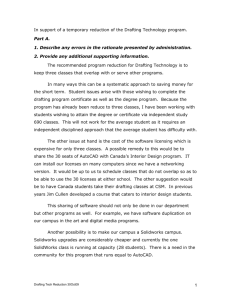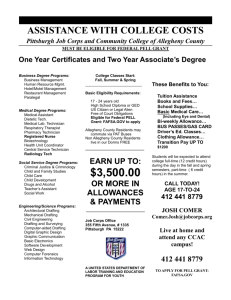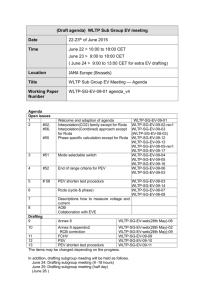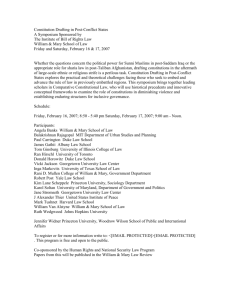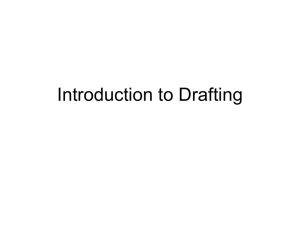Drafting & Gen Engineering - Los Angeles Harbor College
advertisement
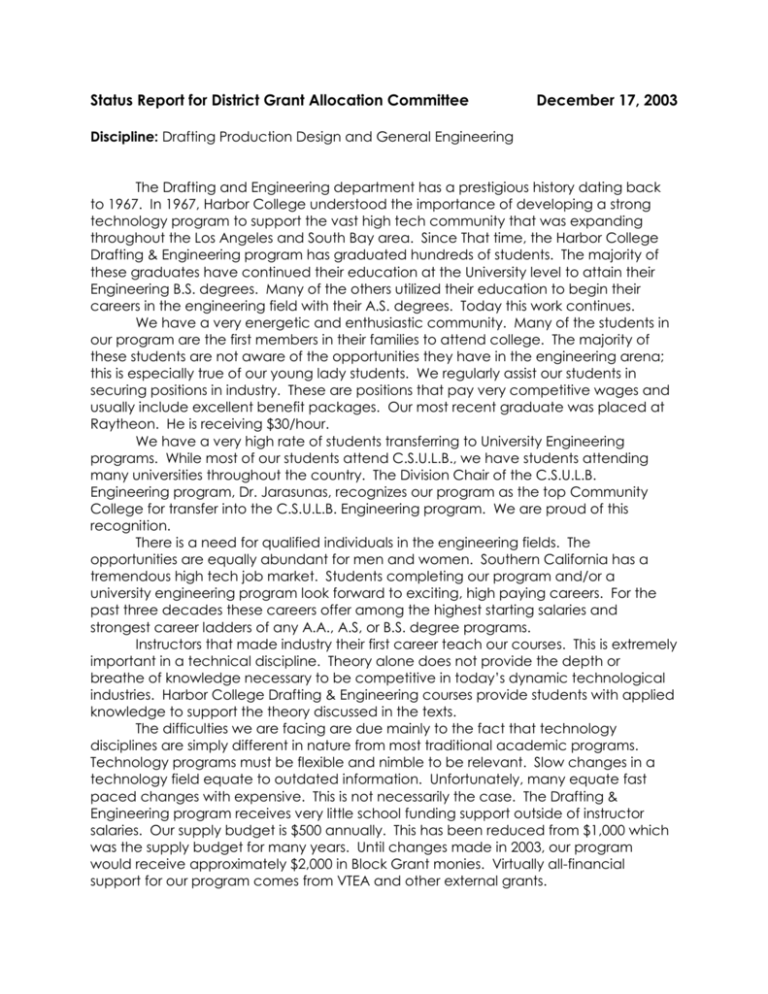
Status Report for District Grant Allocation Committee December 17, 2003 Discipline: Drafting Production Design and General Engineering The Drafting and Engineering department has a prestigious history dating back to 1967. In 1967, Harbor College understood the importance of developing a strong technology program to support the vast high tech community that was expanding throughout the Los Angeles and South Bay area. Since That time, the Harbor College Drafting & Engineering program has graduated hundreds of students. The majority of these graduates have continued their education at the University level to attain their Engineering B.S. degrees. Many of the others utilized their education to begin their careers in the engineering field with their A.S. degrees. Today this work continues. We have a very energetic and enthusiastic community. Many of the students in our program are the first members in their families to attend college. The majority of these students are not aware of the opportunities they have in the engineering arena; this is especially true of our young lady students. We regularly assist our students in securing positions in industry. These are positions that pay very competitive wages and usually include excellent benefit packages. Our most recent graduate was placed at Raytheon. He is receiving $30/hour. We have a very high rate of students transferring to University Engineering programs. While most of our students attend C.S.U.L.B., we have students attending many universities throughout the country. The Division Chair of the C.S.U.L.B. Engineering program, Dr. Jarasunas, recognizes our program as the top Community College for transfer into the C.S.U.L.B. Engineering program. We are proud of this recognition. There is a need for qualified individuals in the engineering fields. The opportunities are equally abundant for men and women. Southern California has a tremendous high tech job market. Students completing our program and/or a university engineering program look forward to exciting, high paying careers. For the past three decades these careers offer among the highest starting salaries and strongest career ladders of any A.A., A.S, or B.S. degree programs. Instructors that made industry their first career teach our courses. This is extremely important in a technical discipline. Theory alone does not provide the depth or breathe of knowledge necessary to be competitive in today’s dynamic technological industries. Harbor College Drafting & Engineering courses provide students with applied knowledge to support the theory discussed in the texts. The difficulties we are facing are due mainly to the fact that technology disciplines are simply different in nature from most traditional academic programs. Technology programs must be flexible and nimble to be relevant. Slow changes in a technology field equate to outdated information. Unfortunately, many equate fast paced changes with expensive. This is not necessarily the case. The Drafting & Engineering program receives very little school funding support outside of instructor salaries. Our supply budget is $500 annually. This has been reduced from $1,000 which was the supply budget for many years. Until changes made in 2003, our program would receive approximately $2,000 in Block Grant monies. Virtually all-financial support for our program comes from VTEA and other external grants. From 1996 through 1999 the Drafting & Engineering program experienced strong, steady growth. In fact, this program became one of, if not the highest WSCH per FTE programs on the campus. This was all accomplished with one FTE and four hourly assignments. A second FTE was requested. The goal was to expand our instruction to include more extensive CNC programming. This expansion was requested by our Advisory Committee due to the future needs of industry throughout Southern California. Our proposal to the FHPC was well received and we were placed on the hire list. However, in order to hire a second FTE our administration insisted that we eliminate two of our hourly assignments. This would result in “no net gain” in hours. This has been a very tough obstacle. The reduction on these assignments resulted in lower WSCH/FTE for our program. We had to make a decision; abandon our reason for hiring our new FTE in order to increase WSCH or continued to develop our CNC programming curriculum which will ultimately provide the best education for our students and provide our campus with increased enrollment. We have chosen to “stay the course” with our planning. Another area that has cost us many students is our lack of MIS support. Our program built a computer lab through outside grant funding. We have volunteered to manage the computers in this lab. Our MIS department rejected this request. We are not given ANY control over these computers. Our MIS department has left us without use of these computers for four of the last seven semesters. The student toll is untold. Students work extensively on computers starting their first semester in the day program and their second semester in the evening program. All of the hardware and software is “in-house” but the computers are not set-up. The students simply leave and do not return. Our reputation is severely damaged by lack of equipment preparedness. We are very proud of the program we offer the relationship we share with our students and our relationship with industry. We believe that our future is strong. The technology field continues to grow, but the supply of qualified individuals is limited. We believe that we can help the members of our community prepare to meet those needs. 1. Define the discipline in terms of relevance and student need. The Drafting & Engineering program receives an annual review from both the instructors and the Advisory Committee. Each course is reviewed for both academic content as well as industry relevance. Industry methodology is infused into every course. As the “state of the industry” changes, our course content and/or processes change. Simply stated, we listen very closely to the input we receive from our Advisory Committee. With the previous statements being made, it is important to state the diversity of our Advisory Committee. This is critical so that there is no misunderstanding as to our broad level of education for our students. The Harbor College Advisory Committee includes: Boeing Aircraft Company, Toyota Motor Sales (Engineering, Advanced Design, Marketing groups), Ace Clearwater Enterprises (advanced aerospace manufacturing), Temcor (commercial/industrial building design), Bentley Medical (surgical equipment manufacturer), Kuster Oil (sub-surface drilling equipment), Northrop/Grumman (aerospace), The Aerospace Corporation (design group), Felbro Inc. (consumer products). This diversity of needs gives us confidence that the recommendations we accept from our advisory committee will provide our students with the information and training they need to be successful in industry. 2. Identify the courses taught in this discipline. The Drafting & Engineering program at Harbor College offer a complete A.S. Degree program. Here is a list of the current courses: Drafting 001/General Engineering 912 – Basic Drafting Drafting 004/General Engineering 911 – Descriptive Geometry Drafting 009 – Mechanical Drafting Drafting 016 – Blueprint Reading I Drafting 017 – Blueprint Reading II Drafting 050/General Engineering 111 – Production Drafting Drafting 051 – Tool Design Drafting 52 – Electro-Mechanical Drafting Drafting 054/General Engineering 243 – Stress Analysis Drafting 055 – Computer Aided Design/Drafting (CADD) Drafting 056 – Computer Aided Manufacturing (CAM) Drafting 081 – Projects Lab Drafting 082 – CAD Lab Two new courses are currently in the approval process: Drafting 006/General Engineering 028 3. Identify factors that influence enrollment; such as, scheduling, combined sections, and unique circumstances. The largest factor influencing enrollment is exposure. Most Community Colleges do not offer a complete Drafting/Engineering program. Unfortunately, most High Schools have discontinued all vocational courses. This has resulted is a lack of awareness of engineering careers for high school students. To deal with this issue we mainly offer afternoon and evening courses. We promote a selection of our courses to high school students and encourage dual enrollment during their senior year of high school. These courses are offered at times accessible by high school students as well as our traditional college students. This scheduling also serves our traditional college students well as it reduces the scheduling conflicts with their General Education courses, especially their extensive math and science courses. We also “stack” sections of courses in order to offer the number of courses necessary for degree attainment while only employing two full time faculty and two hourly assignments. The “stacking” also allows us to offer “advanced” courses that typically experience lower levels of enrollment. 4. List strengths and weaknesses in relation to student needs. Strengths: Our biggest strength is our instruction. Both of our instructors come directly from industry. Both instructors have degrees in technical disciplines. Their experience in industry is nearly 30 years. This brings a level of experience to the classroom that could not be attained through theory alone. The second strength is the industry attitude of “Continuous Improvement”. We are always looking towards the future for direction for this program. Our Advisory Committee plays a major roll in the shaping of this program. Industry relevance is critical to our success. Weaknesses: Our biggest weakness is the lack of understanding of technical careers by other academic disciplines. The majority of disciplines do not prepare students for careers. This creates a lack of understanding as to the “training” aspects of our program. Our students do not simply take a one-hour lecture course and go home to complete homework. Many hours are spent in labs learning the applied aspects of this discipline. This lack of understanding also slows the rate of change necessary in this type of discipline. There are times that rapid dynamic change is necessary to keep pace with industry needs. This does not fit the structure of the traditional education system. However, this is becoming the model for the new educational environment. Another weakness is the lack of preparedness of incoming students. High schools have diverted funding away from career and vocational instruction. They also do very little career counseling. This is very unfortunate for our community, as their children are not being made aware of tremendous career opportunities. A final weakness is the amount of funding currently available. Other than instructor salaries, our program runs almost entirely on grant money. We receive very little financial support from campus funds. Currently, grants monies are more scarce than in prior years. However, this cycle will change and more monies will become available for our needs. 5. Review enrollment data in the LAHC Planning Resource Guide and verify the accuracy of the data and explain any unique circumstances of the discipline offering. This information will be submitted with a detailed analysis in a separate report. Many aspects of the Planning Resource guide need to be accompanied with explanations of offerings and assignments. 6. State conclusions and significant findings. Our Drafting & Engineering program is strong and healthy. We are continuing to listen to our advisory committee for guidance. Our students are well prepared for beginning their careers in engineering professions and or completing their Engineering B.S. degrees. Companies who hire our students report high level of satisfaction with their abilities and education. Our students are receiving excellent salaries and promote quickly into higher positions. Our “working professional” students report satisfaction with the courses they take in our program. Many report sharing their experience with coworkers and others and give positive recommendations. 7. State a plan of action that would strengthen this discipline if indicated. Complete adoption of a General Education course in Technology and Society”. This course would give supportive enrollment to our program and would serve to educate students in the important roll technology serves in our society. This course would also introduce students to technology careers. Continue developing the CNC programming aspects of our program. The studies in this area will give our students a tremendous edge in attaining higher level positions in the future. The new technology building will give our program a new boost. We are already planning for this increase in interest. We are also looking into scheduling possibilities that would make key courses available more frequently for students that may be attending a community college that might, in previous years, attend a university. This change would be due to budget constraints and tuition increases at the universities.

